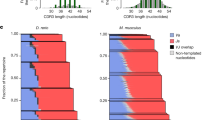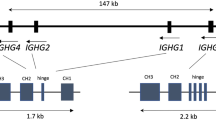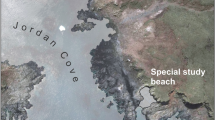Abstract
The I region of the mouse H–2 complex has been subdivided into five subregions (A, B, J, E, C) on the basis of serological and functional analyses of intra-MHC (major histocompatibility complex) recombinant strains1. However, no serologically detectable specificities nor Ir genes have been localized to the I–E subregion of the H–2b and H–2S haplotypes. Attempts to identify I–E gene products of these haplotypes by chemical analyses have also been unsuccessful2,3. Thus, the H–2 complex of these haplotypes seems not to express I–E subregion genes. In this case, alloantisera raised in ‘I–E- negative’ strains of mice against ‘I–E- positive’ mouse cells might contain, in addition to the usual alloantibodies, antibodies reactive with conserved portions of I–E molecules inherited from a hypothetical primordial gene (I–E0) which may have existed long before the speciation of contemporary animals. Such antibodies would show extensive cross-reactions with the I–E homologues of various species of animals. Interspecies cross-reactions of anti-Ia mouse alloantibodies have indeed been observed. Although such a cross-reaction was first found between mouse I–A and rat Ia-homologues, subsequent studies indicated much broader and more frequent interspecies cross-reactions of anti-I–E antibodies4–8. We have now expanded the demonstration of such interspecies cross-reactions to submammalian vertebrates. The possible basis of these unusual cross-reactions and its phylogenetic implication will be discussed.
This is a preview of subscription content, access via your institution
Access options
Subscribe to this journal
Receive 51 print issues and online access
$199.00 per year
only $3.90 per issue
Buy this article
- Purchase on Springer Link
- Instant access to full article PDF
Prices may be subject to local taxes which are calculated during checkout
Similar content being viewed by others
References
Klein, J., Flaherty, L., VandeBerg, J. L. & Shreffler, D. C. Immunogenetics 6, 489–512 (1978).
Jones, P. P., Murphy, D. B. & McDevitt, H. O. J. exp. Med. 148, 925–939 (1978).
Ozato, K., Lunney, J. K., El-Gamil, M. & Sachs, D. H. J. Immun. 125, 940–945 (1980).
Sachs, D. H., Humphrey, G. W. & Lunney, J. K. J. exp. Med. 146, 381–393 (1977).
Shinohara, N., Lunney, J. K. & Sachs, D. H. J. Immun. 121, 637–640 (1978).
Lunney, J. K., Mann, D. L. & Sachs, D. H. Scand. J. Immun. 10, 403–415 (1979).
Lunney, J. K. & Sachs, D. H. J. Immun. 122, 623–627 (1979).
Shinohara, N. & Sachs, D. H. J. Immun. 126, 934–937 (1981).
David, C. S. Transplantn Rev. 30, 299–322 (1976).
Wakeland, E. K. & Klein, J. Immunogenetics 8, 27–39 (1979).
Author information
Authors and Affiliations
Rights and permissions
About this article
Cite this article
Shinohara, N., Sachs, D., Nonaka, N. et al. Phylogenetic tracing of Ia genes. Nature 292, 362–363 (1981). https://doi.org/10.1038/292362a0
Received:
Accepted:
Issue Date:
DOI: https://doi.org/10.1038/292362a0
This article is cited by
-
High frequency ofH-2E 0 alleles among wild mice
Immunogenetics (1989)
-
Xenogeneic monoclonal HLA-specific antibodies defining mouse lymphocyte determinants encoded by the H-2 complex
Immunogenetics (1989)
-
Major histocompatibility complex of the mole-rat
Immunogenetics (1984)
-
Structural polymorphism of human Ia antigens recognized by the monoclonal antibody 12 and by cross-reacting I-Ek-specific alloantibodies
Immunogenetics (1984)
-
I-A homologous antigen on human lymphocytes detected by a monoclonal antibody
Immunogenetics (1983)
Comments
By submitting a comment you agree to abide by our Terms and Community Guidelines. If you find something abusive or that does not comply with our terms or guidelines please flag it as inappropriate.



